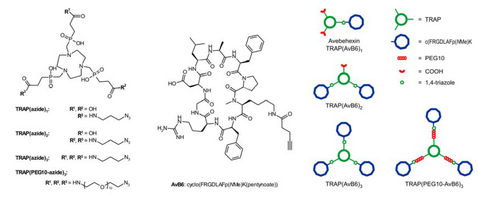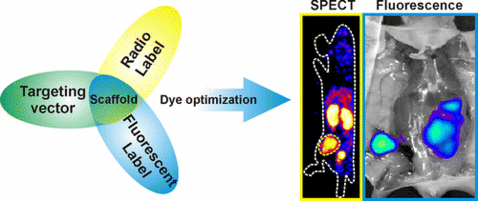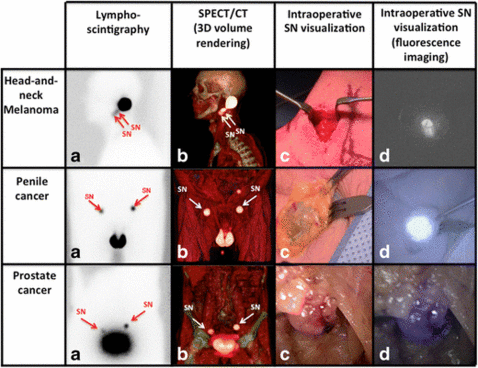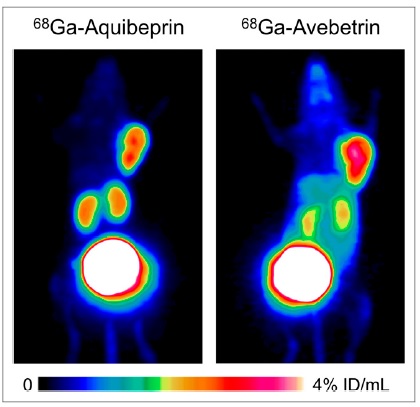In-vivo PET imaging of the "cancer integrin" αvβ6 using gallium-68 labelled cyclic RGD nonapeptides
15.12.2016
Expression of the cellular transmembrane receptor αvβ6 integrin is essentially restricted to malignant epithelial cells in carcinomas of a broad variety of lineages, while it is virtually absent in normal adult tissues. Thus, it is a highly attractive target for tumor imaging and therapy. Furthermore, αvβ6 integrin plays an important role for the epithelial-mesenchymal interaction and the development of fibrosis. [Read more]
Production of clinical radiopharmaceuticals: general pharmaceutical and radioanalytical aspects
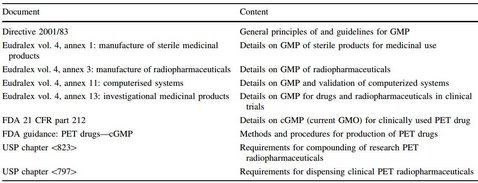
10.12.2016
Due to successes in the development on new and powerful radiopharmaceuticals, in particular of tracers for positron emission tomography, the production of a continuously expanding spectrum of radiopharmaceuticals has become more important, even for small nuclear medicine facilities. This short review summarizes and briefly describes typically established radioanalytical routines in the quality control of radiopharmaceuticals as well as the corresponding fundamental legal documents and guidelines...
Detection rate of PET/CT in patients with biochemical relapse of prostate cancer using [68Ga]PSMA I&T and comparison with published data of [68Ga]PSMA HBED-CC
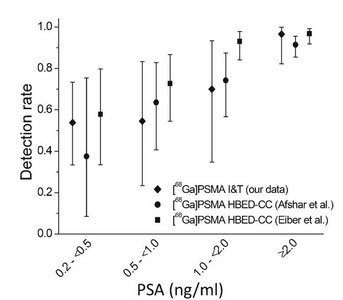
28.11.2016
To determine the detection rate of PET/CT in biochemical relapse of prostate cancer using [68Ga]PSMA I&T and to compare it with published detection rates of [68Ga]PSMA HBED-CC. We performed a retrospective analysis in 83 consecutive patients with documented biochemical relapse after prostatectomy. All patients underwent whole body [68Ga]PSMA I&T PET/CT. PET/CT images were evaluated for presence of local recurrence, lymph node metastases, and distant metastases...
Value of [111In]-prostate-specific membrane antigen (PSMA)-radioguided surgery for salvage lymphadenectomy in recurrent prostate cancer: correlation with histopathology and clinical follow-up
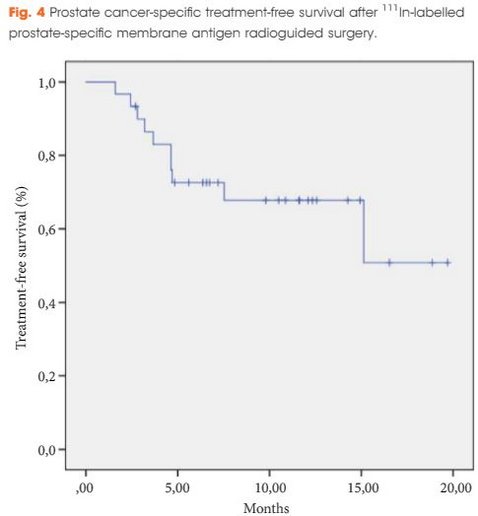
10.11.2016
To evaluate the use of 111In-labelled prostate-specific membrane antigen (PSMA)-I&T-based radioguided surgery (111In-PSMA-RGS) for salvage surgery in recurrent prostate cancer (PCa) using comparison of intra-operative gamma probe measurements with histopathological results of dissected specimens. In addition, to determine the success of 111In-PSMA-RGS with regard to postoperative prostate-specific antigen (PSA) responses, PCa-specific treatment-free survival rates and postoperative complication rates. A total of 31 consecutive patients with localized recurrent PCa undergoing salvage surgery with PSMA-targeted radioguided surgery using a 111In-labelled PSMA…
Imaging the cytokine receptor CXCR4 in atherosclerotic plaques with the radiotracer 68Ga-pentixafor for positron emission tomography
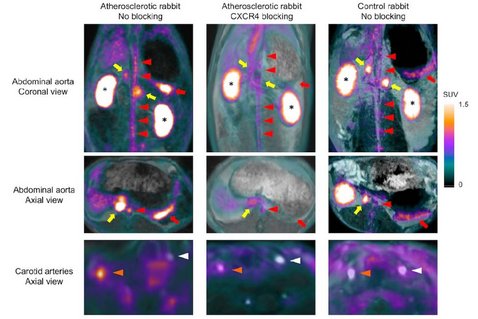
27.10.2016
68Ga-pentixafor is a radiotracer for positron emission tomography (PET) that binds with nanomolar affinity to CXCR4. The CXCR4 receptor is expressed at the surface of inflammatory cells. The objective of the study was to analyze the ability of radiolabeled pentixafor to detect CXCR4 expression on inflammatory cells present in atherosclerotic plaques of an experimental rabbit model. Atherosclerotic plaques were…
Impact of [68Ga]PSMA PET/CT on salvage radiotherapy planning in patients with prostate cancer and persisting PSA values or biochemical relapse after prostatectomy
26.10.2016
Salvage radiotherapy (SRT) is clinically established in prostate cancer (PC) patients with PSA persistence or biochemical relapse (BCR) after prior radical surgery. PET/CT imaging prior to SRT may be performed to localize disease recurrence. The recently introduced 68Ga-PSMA outperforms other PET tracers for detection of recurrence and is therefore expected also to impact radiation planning. Forty-five patients with PSA persistence (16 pts) or BCR (29 pts) after prior prostatectomy, scheduled to undergo SRT of the prostate bed, underwent 68Ga-PSMA PET/CT…
PSMA-Based Radioligand Therapy for Metastatic Castration-Resistant Prostate Cancer: The Bad Berka Experience Since 2013
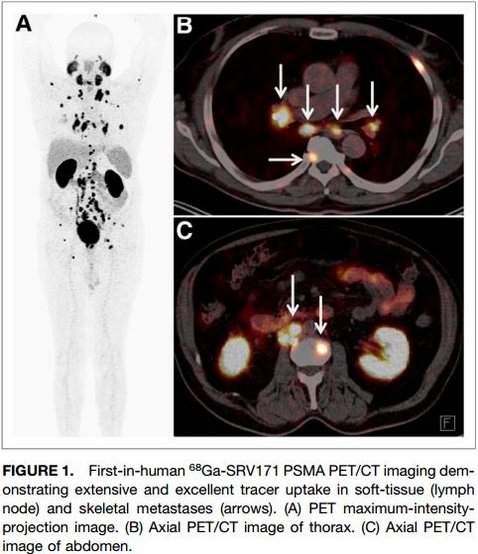
1.10.2016
A potential milestone in personalized nuclear medicine is theranostics of metastatic castration-resistant prostate cancer (mCRPC) based on molecular imaging using PET/CT with 68Ga-labeled prostate-specific membrane antigen (PSMA) ligands and molecular radiotherapy using PSMA-targeted radioligand therapy (PRLT) with 177Lu-PSMA ligands. 68Ga-PSMA PET/CT enables accurate detection of mCRPC lesions with high diagnostic sensitivity and specificity and provides quantitative and reproducible data that can be used to select patients for PRLT and therapeutic monitoring…
Radiation dosimetry for 177Lu-PSMA-I&T in metastatic castration-resistant prostate cancer: Absorbed dose in normal organs and tumor lesions
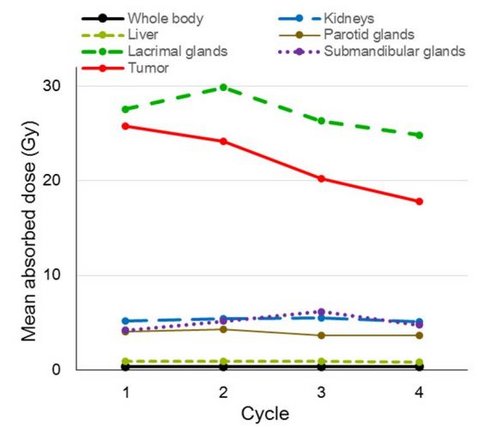
22.09.2016
Prostate-specific membrane antigen (PSMA) targeted radioligand therapy (RLT) is increasingly used in metastatic castration-resistant prostate cancer (mCRPC). We aimed to estimate the absorbed doses for normal organs and tumor lesions using 177Lu-PSMA-I&T in patients undergoing up to four cycles RLT. Results were compared to pre-therapeutic 68Ga-PSMA-HBED-CC positron-emission-tomography (PET). A total of 34 cycles in 18 patients were analyzed retrospectively. In 15 patients the first, in 9 the second, in 5 the third and in 5 the fourth cycle was analyzed, respectively...
Preclinical evaluation of [(68)Ga]NOTA-pentixafor for PET imaging of CXCR4 expression in vivo - a comparison to [(68)Ga]pentixafor
21.09.2016
Due to its overexpression in a variety of tumor types, the chemokine receptor 4 (CXCR4) represents a highly relevant diagnostic and therapeutic target in nuclear oncology. Recently, [(68)Ga]pentixafor has emerged as an excellent imaging agent for positron emission tomography (PET) of CXCR4 expression in vivo. In this study, the corresponding [(68)Ga]-1,4,7-triazacyclononane-triacetic acid (NOTA) analog was preclinically evaluated…
Preclinical evaluation and first patient application of 99mTc-PSMA-I&S for SPECT imaging and radioguided surgery in prostate cancer
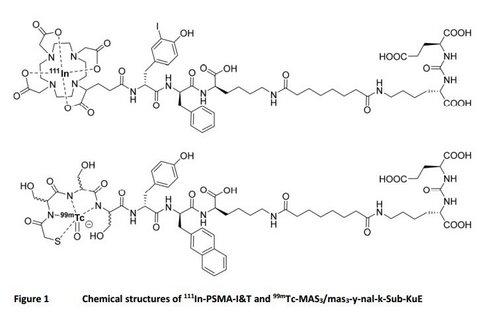
15.09.2016
Initial studies in patients have demonstrated the suitability of 111In-PSMA-I&T (111In-DOTAGA-(3-iodo-y)-f-k-Sub(KuE)) for radioguided surgery (RGS) of small metastatic prostate cancer (PCa) soft tissue lesions. To meet the clinical need for a more cost-effective alternative, the PSMA-I&T-based tracer concept was adapted to 99mTc-labeling chemistry. Two PSMA-I&T-derived inhibitors with all-L-serine- (MAS3) and all-D-serine- (mas3) chelating moieties were evaluated in parallel, and a kit procedure for routine 99mTc-labeling was developed…
[68Ga]Pentixafor-Positron Emission Tomography/Computed Tomography Detects Chemokine Receptor CXCR4 Expression After Ischemic Stroke
09.09.2016
A 64-year-old female with primarily diagnosed small cell lung cancer was referred to our department for positron emission tomography (PET)/computed tomography work-up with [18F]FDG and [68Ga]Pentixafor, a radiotracer for CXC-motif chemokine receptor 4, with the latter being performed on a compassionate use basis...
Evaluation of 68Ga-Glutamate Carboxypeptidase II Ligand Positron Emission Tomography for Clinical Molecular Imaging of Atherosclerotic Plaque Neovascularization
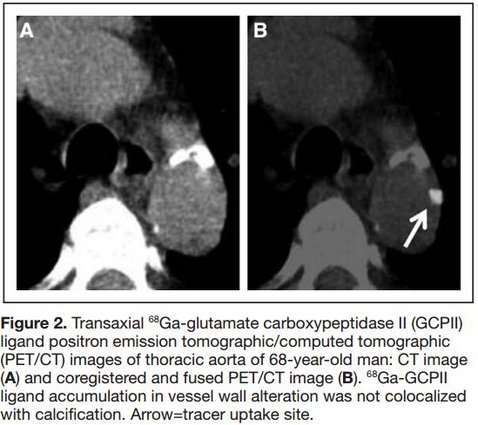
8.9.2016
Intraplaque neovascularization contributes to the progression and rupture of atherosclerotic lesions. Glutamate carboxypeptidase II (GCPII) is strongly expressed by endothelial cells of tumor neovasculature and plays a major role in hypoxia-induced neovascularization in rodent models of benign diseases. We hypothesized that GCPII expression may play a role in intraplaque neovascularization and may represent a target for imaging of atherosclerotic lesions. The aim of this study was to determine frequency, pattern, and clinical correlates of vessel wall uptake of a 68Ga-GCPII ligand for positron emission tomographic imaging...
Intrapatient Comparison of 111In-PSMA I&T SPECT/CT and Hybrid 68Ga-HBED-CC PSMA PET in Patients With Early Recurrent Prostate Cancer
01.09.2016
The aim of this study was to evaluate the detection efficiency of In-PSMA-I&T SPECT/CT in comparison to hybrid Ga-PSMA HBED-CC PET in patients with early recurrent prostate cancer. Twenty-two patients (mean age, 68.2 ± 6.8 years; range, 52-76 years) with rising prostate-specific antigen (PSA; median, 1.03 ng/mL; range, 0.2-7.2ng/mL) and known positive lesions in hybrid Ga-PSMA HBED-CC PET scheduled for salvage surgery were included. Whole-body scintigraphy and SPECT/CT were performed 4 hours after application of 147.0 ± 24.8 MBq (range, 90-183 MBq) In-PSMA I&T…
68Ga-PSMA-PET/CT in Patients With Biochemical Prostate Cancer Recurrence and Negative 18F-Choline-PET/CT
01.07.2016
Investigating the value of Ga-PSMA-PET/CT in biochemically recurring prostate cancer patients with negative F-choline-PET/CT. One hundred thirty-nine consecutive patients with biochemical recurrence after curative (surgery and/or radiotherapy) therapy were offered participation in this sequential clinical imaging approach. Patients first underwent an F-choline-PET/CT. If negative, an additional Ga-PSMA-PET/CT was offered. One hundred twenty-five of 139 eligible patients were included in the study; 32 patients underwent additional Ga-PSMA-PET/CT…
A Practical Guide on the Synthesis of Metal Chelates for Molecular Imaging and Therapy by Means of Click Chemistry
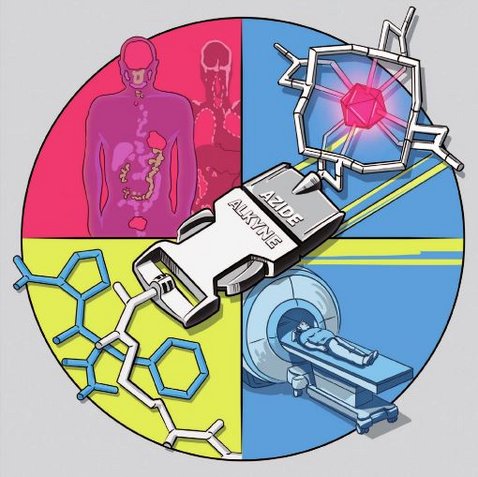
22.6.2016
The copper-catalyzed cycloaddition of organic azides and alkynes (CuAAC) is one of the most popular reactions for rapid assembly of multifunctional molecular frameworks from commercially available building blocks. It is also attractive for synthesis of conjugates of multidentate chelate ligands (chelators) with molecular targeting vectors, such as peptides or proteins, which serve as precursors for labeling with metal radionuclides or are useful as MRI contrast agents...
First 18F-labeled Pentixafor-based Imaging Agent for PET Imaging of CXCR4-expression in Vivo
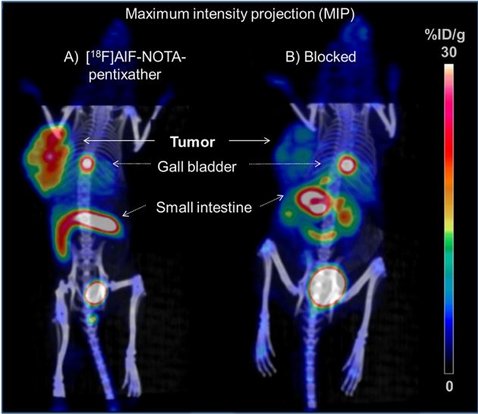
12.06.2016
In vivo quantification of CXCR4 expression using [68Ga]pentixafor for positron emission tomography (PET) imaging has gained significant clinical interest as CXCR4 plays a fundamental role in oncology and possesses potential prognostic value when overexpressed. To combine the excellent CXCR4-targeting properties of pentixafor-based tracers with the favorable radionuclide properties of 18F for high-resolution PET imaging, we developed…
[68Ga]PSMA ligand PET/CT-based radiotherapy in locally recurrent and recurrent oligometastatic prostate cancer : Early efficacy after primary therapy
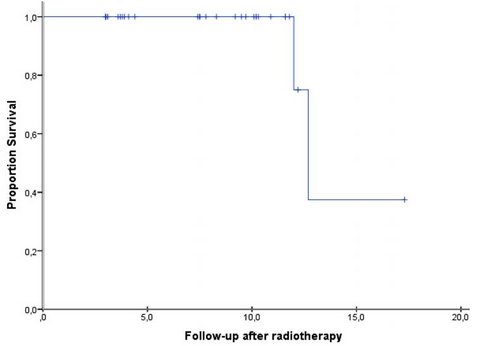
01.06.2016
The goal of this work was to evaluate the early efficacy of (68)Ga-PSMA ligand PET/CT imaging for radiotherapy of locally recurrent and/or oligometastatic prostate cancer. A total of 29 patients with biochemical recurrence received a (68)Ga-PSMA ligand PET/CT for restaging of disease, followed by 3D conformal radiotherapy of metastases or intensity-modulated radiation therapy of the prostate bed. Prostate-specific antigen (PSA) levels and imaging procedures served as the reference standard to assess the treatment efficacy…
Biodistribution and radiation dosimetry of (68)Ga-PSMA HBED CC-a PSMA specific probe for PET imaging of prostate cancer
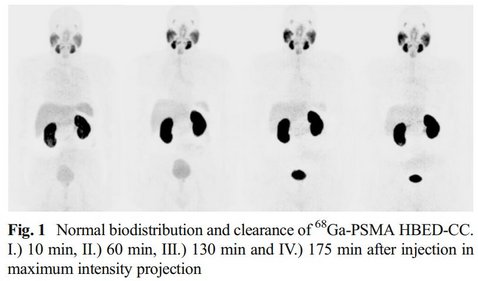
20.05.2016
Positron emission tomography (PET) agents targeting the prostate-specific membrane antigen (PSMA) are currently under broad clinical and scientific investigation. (68)Ga-PSMA HBED-CC constitutes the first (68)Ga-labelled PSMA-inhibitor and has evolved as a promising agent for imaging PSMA expression in vivo. The aim of this study was to evaluate the whole-body distribution and radiation dosimetry of this new probe…
Targeted positron emission tomography imaging of CXCR4 expression in patients with acute myeloid leukemia
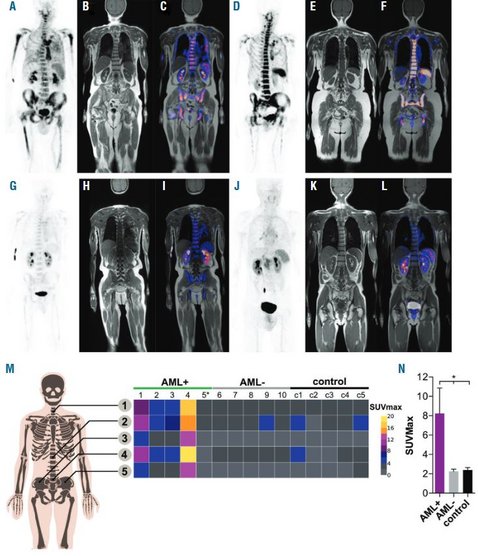
12.05.2016
Acute myeloid leukemia originates from leukemia-initiating cells that reside in the protective bone marrow niche. CXCR4/CXCL12 interaction is crucially involved in recruitment and retention of leukemia-initiating cells within this niche. Various drugs targeting this pathway have entered clinical trials. To evaluate CXCR4 imaging in acute myeloid leukemia, we first tested CXCR4 expression in patient-derived primary blasts. Flow cytometry revealed…
Variation of Specific Activities of 68Ga-Aquibeprin and 68Ga-Avebetrin Enables Selective PET Imaging of Different Expression Levels of Integrins α5β1 and αvβ3
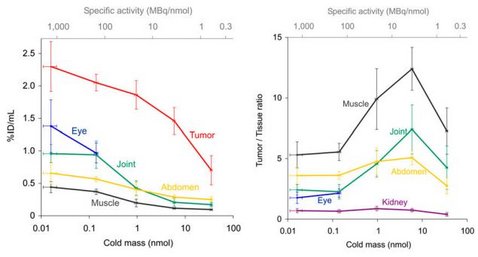
5.5.2016
68Ga-aquibeprin and 68Ga-avebetrin are tracers for selective in vivo mapping of integrins α5β1 and αvβ3, respectively, by PET. Because both tracers exhibit high affinity to their respective targets, the aim of this study was to investigate the influence of the specific activity of preparations of both tracers on in vivo imaging results...
The influence of different metal-chelate conjugates of pentixafor on the CXCR4 affinity

26.4.2016
The overexpression of the chemokine receptor 4 (CXCR4) in different epithelial, mesenchymal, and hematopoietic cancers makes CXCR4 an attractive diagnostic and therapeutic target. However, targeting the CXCR4 receptor with small cyclic pentapeptide-based radiopharmaceuticals remains challenging because minor structural modifications within the ligand-linker-chelate structure often significantly affect the receptor affinity. Based on the excellent in vivo properties of…
Tailoring Fluorescent Dyes To Optimize a Hybrid RGD-Tracer
13.04.2016
Quantitative assessment of affinity and kinetics is a critical component in the development of (receptor-targeted) radiotracers. For fluorescent tracers, such an assessment is currently not yet applied, while (small) changes in chemical composition of the fluorescent component might have substantial influence on the overall properties of a fluorescent tracer. Hybrid imaging labels that contain both a radiolabel and a fluorescent dye can be used to evaluate both the affinity (fluorescent label) and the in vivo distribution ...
Towards Personalized Treatment of Prostate Cancer: PSMA I&T, a Promising Prostate-Specific Membrane Antigen-Targeted Theranostic Agent
12.04.2016
Prostate-specific membrane antigen (PSMA) is a well-established target for nuclear imaging and therapy of prostate cancer (PCa). Radiolabeled small-molecule PSMA inhibitors are excellent candidates for PCa theranostics—they rapidly and efficiently localize in tumor lesions. However, high tracer uptake in kidneys and salivary glands are major concerns for therapeutic applications. Here, we present the preclinical application of PSMA I&T, a DOTAGA-chelated urea-based PSMA inhibitor, for SPECT/CT imaging and radionuclide therapy of PCa…
68Ga-PSMA I&T PET/CT for assessment of prostate cancer: evaluation of image quality after forced diuresis and delayed imaging
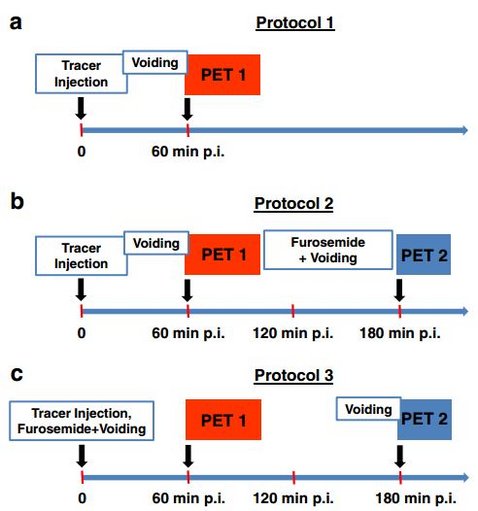
24.03.2016
Urinary radiotracer excretion of 68Ga-Labelled prostate-specific membrane antigen (PSMA) ligands may complicate the assessment of the prostate region and differentiation of lymph nodes from ureteral activity. The aim of this study was to assess the value of delayed imaging after forced diuresis. Sixty-six patients underwent 68Ga-PSMA I&T PET/CT for evaluation of prostate cancer at 60 min post-injection. In subgroups of patients, this was amended by delayed imaging after 180 min post-injection, preceded by furosemide and oral hydration early, at the time of tracer injection, or delayed, at 100 min post-injection…
Fluorescence guided surgery and tracer-dose, fact or fiction?
11.03.2016
Fluorescence guidance is an upcoming methodology to improve surgical accuracy. Challenging herein is the identification of the minimum dose at which the tracer can be detected with a clinical-grade fluorescence camera. Using a hybrid tracer such as indocyanine green (ICG)-99mTc-nanocolloid, it has become possible to determine the accumulation of tracer and correlate this to intraoperative fluorescence-based identification rates. In the current study, we determined the lower detection limit ...
Systemic Radioligand Therapy with (177)Lu Labeled Prostate Specific Membrane Antigen Ligand for Imaging and Therapy in Patients with Metastatic Castration Resistant Prostate Cancer
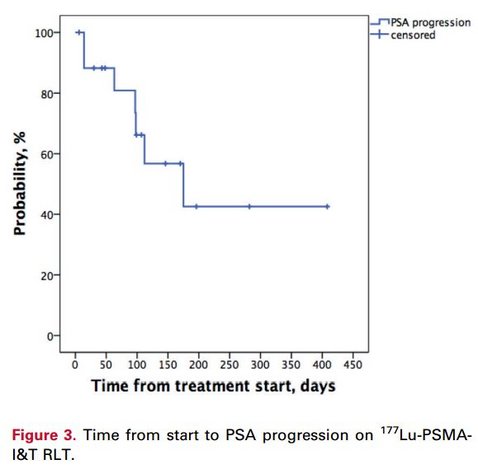
08.03.2016
We report our initial clinical experience with β -emitting (177)Lu-PSMA-I&T ((177)Lu labeled prostate specific membrane antigen ligand for imaging and therapy) for systemic treatment of metastatic castration resistant prostate cancer. Patients with metastatic castration resistant prostate cancer who experienced treatment failure with chemotherapy and novel androgen receptor targeted therapy were treated for 8 weeks with up to 4 cycles of (177)Lu-PSMA-I&T. We report safety data…
Complementary, Selective PET Imaging of Integrin Subtypes α5β1 and αvβ3 Using 68Ga-Aquibeprin and 68Ga-Avebetrin
01.03.2016
Despite in vivo mapping of integrin αvβ3 expression being thoroughly investigated in recent years, its clinical value is still not well defined. For imaging of angiogenesis, the integrin subtype α5β1 appears to be a promising target, for which purpose we designed the PET radiopharmaceutical 68Ga-aquibeprin.
(68)Ga-Pentixafor-PET/CT for Imaging of Chemokine Receptor 4 Expression in Glioblastoma
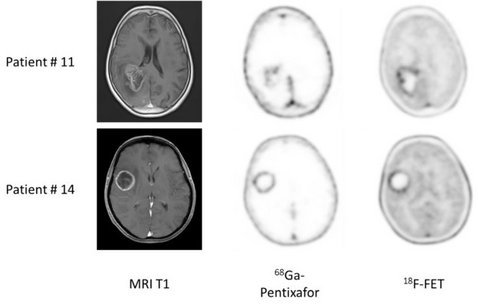
25.01.2016
Chemokine receptor-4 (CXCR4) has been reported to be overexpressed in glioblastoma (GBM) and to be associated with poor survival. This study investigated the feasibility of non-invasive CXCR4-directed imaging with positron emission tomography/computed tomography (PET/CT) using the radiolabelled chemokine receptor ligand (68)Ga-Pentixafor. 15 patients with clinical suspicion on primary or recurrent glioblastoma…
[68Ga]Pentixafor-PET/CT for imaging of chemokine receptor 4 expression in small cell lung cancer-initial experience
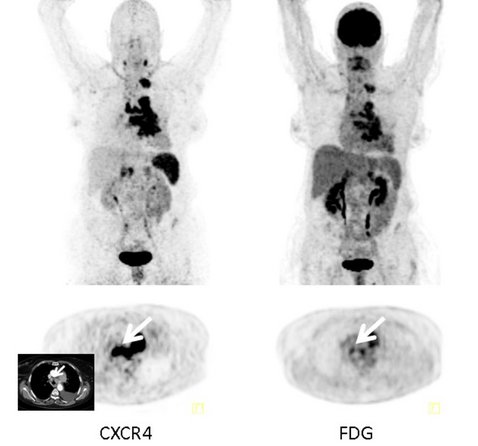
25.01.2016
Chemokine receptor CXCR4 is a key factor for tumor growth and metastasis in several types of human cancer. This study investigated the feasibility of CXCR4-directed imaging of small cell lung cancer (SCLC) with positron emission tomography/computed tomography (PET/CT) using the radiolabelled chemokine ligand [68Ga]Pentixafor. 10 patients with primarily diagnosed (n=3) or pre-treated (n=7) SCLC (n=9) or large cell neuroendocrine carcinoma…
177Lu-Labeled Prostate-Specific Membrane Antigen Radioligand Therapy of Metastatic Castration-Resistant Prostate Cancer: Safety and Efficacy
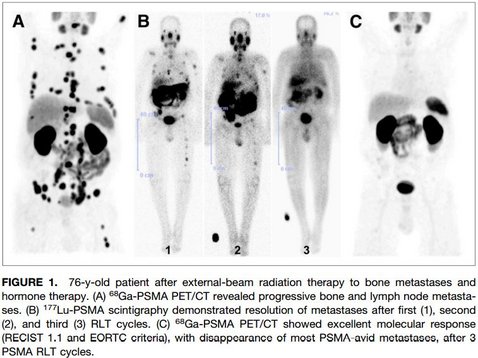
21.01.2016
The objective of this study was to analyze the safety and efficacy of the (177)Lu-labeled DOTAGA-based prostate-specific membrane antigen (PSMA) ligand (177)Lu-DOTAGA-(I-y)fk(Sub-KuE) ((177)Lu-PSMA) in patients with metastatic castration-resistant prostate cancer (mCRPC). Fifty-six mCRPC patients underwent PSMA radioligand therapy (RLT) with (177)Lu-PSMA. (68)Ga-PSMA-(N,N'-bis-[2-hydroxy-5-(carboxyethyl)benzyl]ethylenediamine-N,N'-diacetic acid) ((68)Ga-PSMA) PET/CT was used for patient selection and follow-up after PSMA RLT…
Simultaneous 68Ga-PSMA HBED-CC PET/MRI Improves the Localization of Primary Prostate Cancer
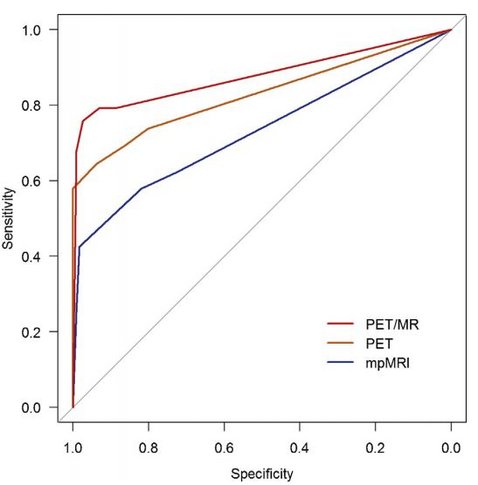
18.01.2016
Ligands of the prostate-specific membrane antigen (PSMA) show promising results in positron emission tomography (PET) imaging of prostate cancer (PCa). To compare the diagnostic performance of simultaneous gallium 68 (68Ga)-PSMA HBED-CC PET/magnetic resonance imaging (MRI) for localization of primary PCa with multiparametric magnetic resonance imaging (mpMRI) and PET alone. We performed 68Ga-PSMA HBED-CC PET/MRI in 66 men with biopsy-proven PCa. PET, mpMRI, and combined 68Ga-PSMA HBED-CC PET/MRI were independently evaluated using Prostate Imaging Reporting and Data System criteria or a 5-point Likert scale…
First Experience with Chemokine Receptor CXCR4-Targeted PET Imaging of Patients with Solid Cancers
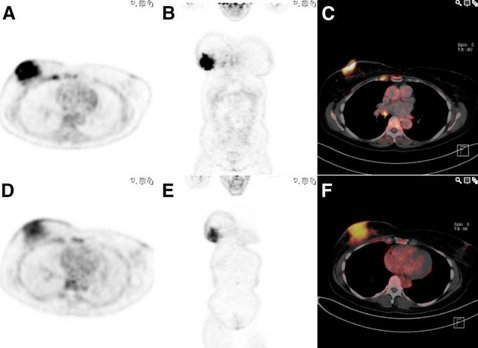
14.01.2016
CXCR4 is a chemokine receptor that is overexpressed in various human cancers and is involved in tumor metastasis. The aim of this proof-of-concept study was to evaluate a novel CXCR4-targeted PET probe in patients with solid cancers with reported in vitro evidence of CXCR4 overexpression and to estimate its potential diagnostic value. Twenty-one patients with histologically proven pancreatic cancer…
